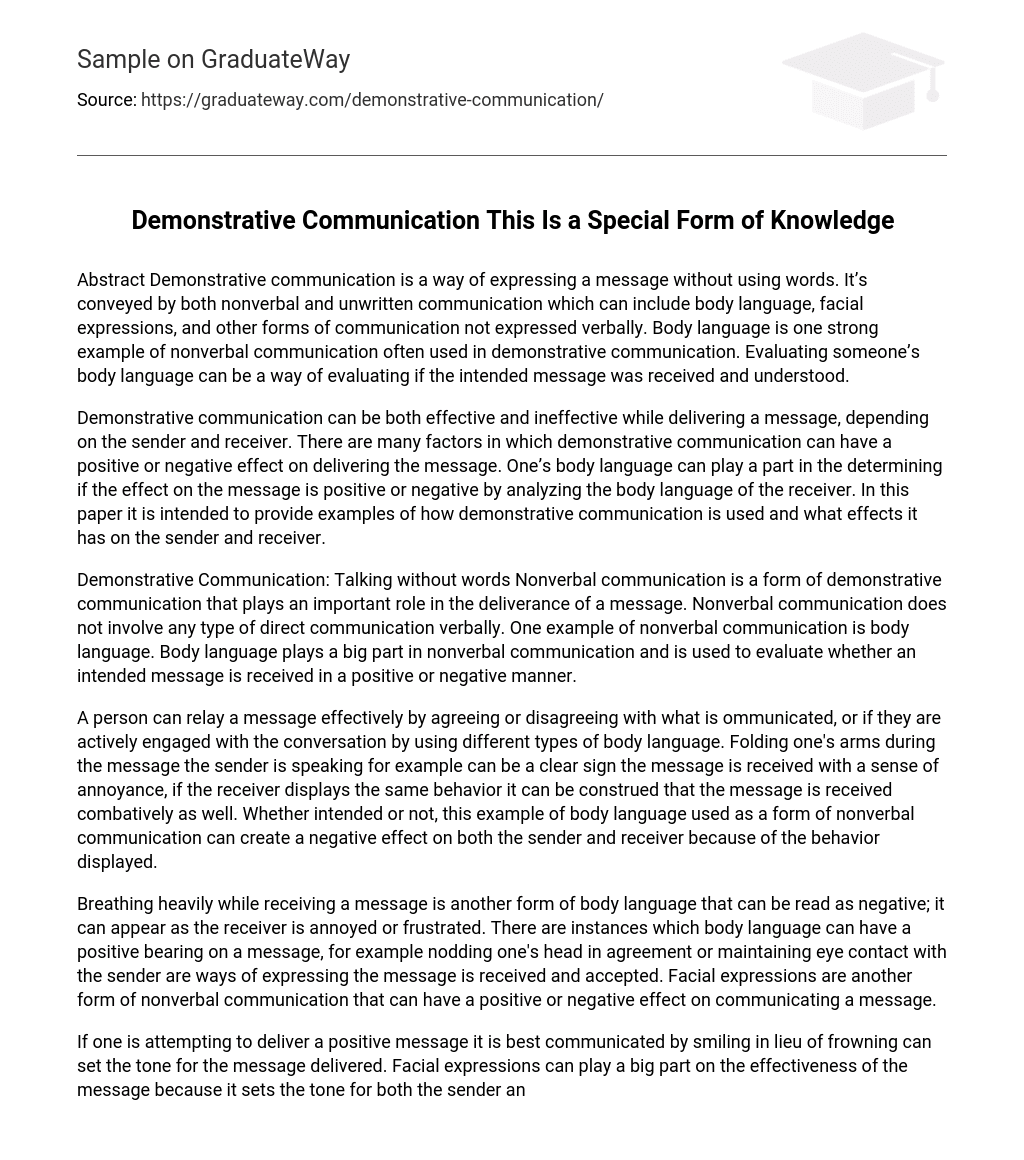Abstract
Demonstrative communication is a way of expressing a message without using words. It is conveyed through nonverbal and unwritten communication, which can include body language, facial expressions, and other forms of communication not expressed verbally. Body language is one strong example of nonverbal communication often used in demonstrative communication. Evaluating someone’s body language can be a way to determine if the intended message was received and understood.
Demonstrative communication can be effective or ineffective in delivering a message, depending on the sender and receiver. There are several factors that determine whether demonstrative communication has a positive or negative effect on message delivery. Body language is one such factor, as it can reveal how the receiver is reacting to the message. This paper will provide examples of how demonstrative communication is used and its effects on both sender and receiver.
Demonstrative Communication: Talking without Words
Nonverbal communication is a form of demonstrative communication that plays an important role in delivering a message. It does not involve direct verbal communication. One example of nonverbal communication is body language, which plays a significant part in evaluating whether an intended message is received positively or negatively.
A person can effectively relay a message by either agreeing or disagreeing with what is being communicated or by actively engaging in the conversation using different types of body language. For example, folding one’s arms during the sender’s message can be a clear sign that the message is received with a sense of annoyance. If the receiver displays the same behavior, it can be construed that the message is received combatively as well. Whether intended or not, this example of body language used as a form of nonverbal communication can create a negative effect on both the sender and receiver due to their displayed behavior.
Breathing heavily while receiving a message is another form of negative body language, as it can make the receiver appear annoyed or frustrated. However, there are instances where body language can have a positive impact on a message. For example, nodding one’s head in agreement or maintaining eye contact with the sender are ways of expressing that the message has been received and accepted. Facial expressions are also an important form of nonverbal communication that can either positively or negatively affect how a message is communicated.
If one is attempting to deliver a positive message, it is best communicated by smiling instead of frowning. Facial expressions can play a big part in the effectiveness of the message because they set the tone for both the sender and the receiver. If either person uses the wrong” expression, it can have an effect on how the message is delivered and received. If a receiver rolls their eyes during a communicated message, it is perceived that the intended message is not accepted positively by them. This negative reaction can also set the tone of the message.
Non-verbal communication can have both positive and negative effects on the message delivered. One can also safely interpret that a message is not received through body language as well. Looking around the room, not maintaining eye contact, or checking the clock or watch are all ways of letting the sender know that the intended message is not received.
If a message is received and accepted, it can give the sender assurance that they have communicated effectively and delivered their message with a positive outlook. However, if there is negative feedback either verbally or non-verbally, the sender may feel as if their message was not effectively communicated or received. This negative feedback may influence them to choose another form of communication.
The primary intent of the sender is to effectively deliver the intended message and ensure that the receiver understands it. Active listening is another form of nonverbal communication. If the receiver displays actions such as nodding in agreement, smiling, or maintaining eye contact, it gives the sender positive feedback confirming that the message was received.
Demonstrative communication is a powerful channel for conveying a message without using words but through behaviors, such as body language and facial expressions. Depending on how it’s used, it can have either a positive or negative impact on the intended message. This type of communication is effective when used as feedback for the sender of the message, and it can also determine if the intended message was received. Both the sender and receiver play an important role in delivering and receiving messages when using demonstrative communication.





